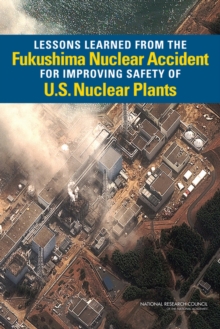The March 11, 2011, Great East Japan Earthquake and tsunami sparked a humanitarian disaster in northeastern Japan.
They were responsible for more than 15,900 deaths and 2,600 missing persons as well as physical infrastructure damages exceeding $200 billion.
The earthquake and tsunami also initiated a severe nuclear accident at the Fukushima Daiichi Nuclear Power Station.
Three of the six reactors at the plant sustained severe core damage and released hydrogen and radioactive materials.
Explosion of the released hydrogen damaged three reactor buildings and impeded onsite emergency response efforts.
The accident prompted widespread evacuations of local populations, large economic losses, and the eventual shutdown of all nuclear power plants in Japan. Lessons Learned from the Fukushima Nuclear Accident for Improving Safety and Security of U.S.
Nuclear Plants is a study of the Fukushima Daiichi accident.
This report examines the causes of the crisis, the performance of safety systems at the plant, and the responses of its operators following the earthquake and tsunami.
The report then considers the lessons that can be learned and their implications for U.S. safety and storage of spent nuclear fuel and high-level waste, commercial nuclear reactor safety and security regulations, and design improvements.
Lessons Learned makes recommendations to improve plant systems, resources, and operator training to enable effective ad hoc responses to severe accidents.
This report's recommendations to incorporate modern risk concepts into safety regulations and improve the nuclear safety culture will help the industry prepare for events that could challenge the design of plant structures and lead to a loss of critical safety functions. In providing a broad-scope, high-level examination of the accident, Lessons Learned is meant to complement earlier evaluations by industry and regulators.
This in-depth review will be an essential resource for the nuclear power industry, policy makers, and anyone interested in the state of U.S. preparedness and response in the face of crisis situations. Table of ContentsFront MatterSynopsisSummary1 Introduction2 Background on Japanese and U.S.
Nuclear Plants3 Great East Japan Earthquake and Tsunami and Impacts on JapaneseNuclear Plants4 Fukushima Daiichi Nuclear Accident5 Lessons Learned: Plant Operations and Safety Regulations6 Lessons Learned: Offsite Emergency Management7 Lessons Learned: Nuclear Safety CultureReferencesAppendix A: Biographical Sketches of Committee, Technical Advisor,and StaffAppendix B: Presentations, Breakout Sessions, and VisitsAppendix C: Detailed Accident Time LineAppendix D: Operation and Support OrganizationsAppendix E: Recommendations from Other OrganizationsAppendix F: Regulator and Industry Actions in the United StatesAppendix G: Hydrogen Control in Severe AccidentsAppendix H: Nuclear Plant Emergency Procedures and GuidelinesAppendix I: Probabilistic Risk AssessmentAppendix J: Human Reliability AnalysisAppendix K: Tsunami Hazards in the Atlantic Ocean BasinAppendix L: Factoring the Costs of Severe Nuclear Accidents intoBackfit DecisionsAppendix M: Access to Timely and Reliable Information to SupportDecision Making During a Nuclear Power Plant AccidentAppendix N: Conversions and UnitsAppendix O: Acronyms

